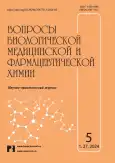Influence of Lophanthus chinensis dry extract on the morphofunctional state of Wistar rats the brain during long-term alcoholization
- Авторлар: Razuvaeva Y.G.1, Khaltagarova E.D.1,2, Toropova А.А.1, Markova К.V.1, Olennikov D.N.1
-
Мекемелер:
- Institute of General and Experimental Biology SB RAS
- Banzarov Buryat State University
- Шығарылым: Том 27, № 5 (2024)
- Беттер: 65-71
- Бөлім: Problems of experimental biology and medicine
- URL: https://journal-vniispk.ru/1560-9596/article/view/315989
- DOI: https://doi.org/10.29296/25877313-2024-05-08
- ID: 315989
Дәйексөз келтіру
Аннотация
The study purpose – to evaluate the effect of the Lophanthus chinensis dry extract on the Wistar rats brain morphofunctional state against the background of long-term alcoholization.
Material and methods. Alcohol intoxication was induced by long-term administration (6 weeks) of 40% ethanol in rats. Lophanthus chinensis dry extract at a dose of 100 mg/kg was administered from the 3rd week of the experiment. On days 42-45, the animals were tested in an "open field", an elevated plus maze, and they developed a conditioned passive avoidance reaction. After which a neurons pathomorphological study in the cerebral cortex was carried out.
Results. It has been established that L. chinensis dry extract exhibits a neuroprotective effect during long-term alcohol intoxication, preventing the development of structural disorders in the cerebral cortex, thereby reducing anxiety and emotionality in animals, enhancing orientation-exploratory activity and normalizing mnestic functions.
Conclusion. L. chinensis dry extract has a neuroprotective effect during long-term alcohol intoxication.
Толық мәтін
##article.viewOnOriginalSite##Авторлар туралы
Ya. Razuvaeva
Institute of General and Experimental Biology SB RAS
Хат алмасуға жауапты Автор.
Email: tatur75@mail.ru
Dr.Sc. (Biol.), Senior Research Scientist
Ресей, Ulan-Ude, Republic of BuryatiaE. Khaltagarova
Institute of General and Experimental Biology SB RAS; Banzarov Buryat State University
Email: haltik@yandex.ru
Post-graduate Student, Lecturer
Ресей, Ulan-Ude, Republic of Buryatia; Ulan-Ude, Republic of BuryatiaА. Toropova
Institute of General and Experimental Biology SB RAS
Email: anyuta-tor@mail.ru
Ph.D. (Biol.), Senior Research Scientist
Ресей, Ulan-Ude, Republic of BuryatiaК. Markova
Institute of General and Experimental Biology SB RAS
Email: kristen_kartland@mail.ru
Ph.D. (Med.), Senior Research Scientist
Ресей, Ulan-Ude, Republic of BuryatiaD. Olennikov
Institute of General and Experimental Biology SB RAS
Email: tatur75@mail.ru
Dr.Sc. (Pharm.), Head laboratory
Ресей, Ulan-Ude, Republic of BuryatiaӘдебиет тізімі
- Global, regional, and national age-sex-specific mortality for 282 causes of death in 195 countries and territories, 1980–2017: a systematic analysis for the Global Burden of Disease Study 2017. Lancet. 2018; 392: 1736–1788. doi: 10.1016/S0140-6736 (18)32203-7.
- Singal A.K., Mathurin P. Diagnosis and treatment of alcohol-associated liver disease: A review. JAMA. 2021; 326(2): 165–176. doi: 10.1001/jama.2021.7683.
- Yoshiji H., Nagoshi S., Akahane T., et al. Evidence-based clinical practice guidelines for liver cirrhosis. J. Gastroenterol. 2020; 56: 593–619. doi: 10.1007/s00535-021-01788-x
- Tranah T.H., Paolino A., Shawcross D.L. Pathophysiological mechanisms of hepatic encephalopathy. Clin. Liver Dis. (Hoboken). 2015; 5(3): 59–63. doi: 10.1002/cld.445.
- Ilchenko L.Yu., Nikitin I.G. Hyperammonemia in patients at the pre-cirrhotic stage: a clinical reality? Archives of Internal Medicine. 2018; 8(3): 186–193. doi: 10.20514/2226-6704-2018-8-3-186-193.
- Kornerup L.S., Gluud L.L., Vilstrup H., Dam G. Update on the therapeutic management of hepatic encephalopathy. Curr. Gastroenterol. Rep. 2018; 20(5): 21. doi: 10.1007/s11894-018-0627-8.
- Aseeva T.A., Dashiev D.B., Dashiev A.D. i dr. Tibetan medicine among the Buryats. – Novosibirsk: Publishing House SB RAS. 2008; 324 p.
- Batorova S.M., Yakovlev G.P., Aseeva T.A. Directory of medicinal plants of traditional Tibetan medicine. Novosibirsk: Nauka, 2013. –292 p.
- Brun E.A., Polunina A.G. Depression, anxiety disorders and antisocial personality disorder as risk factors or consequences of alcoholism and drug addiction: gender aspects. Narcology. 2018; 11: 74–85. doi: 10.25557/1682-8313.2018.11.74-85.
- Guidelines for conducting preclinical studies of drugs. Part one. Ed. A.N. Mironov. M.: Grif and K. 2012; 944.
- Microscopic technique: Guide. Ed. D.S. Sarkisova and Yu.L. Perova. M.: Medicine. 1996; 544 p.
- Olennikov D.N., Chirikova N.K., Tankhaeva L.M. Chemical study of Lophanthus chinensis. Chemistry of natural compounds. 2010; 46 (2): 301–302. doi: 10.1007/s10600-010-9596-3.
- Olennikov D.N., Tankhaeva L.M., Rokhin A.V. Lamiaceae carbohydrates. VI. water-soluble polysaccharides from Lophanthus chinensis. Chemistry of natural compounds. 2009; 45(3): 300–303. doi: 10.1007/s10600-009-9358-2.
- Tanaka N., Yamada K., Shimomoto Y., et al. Lophachinins A-E, abietane diterpenes from a Mongolian traditional herbal medicine Lophanthus chinensis. Fitoterapia. 2020; 146: 104702. doi: 10.1016/j.fitote.2020.104702.
- Han Y., Zhang T., Su J., et al. Apigenin attenuates oxidative stress and neuronal apoptosis in early brain injury following subarachnoid hemorrhage. J. Clin. Neurosci. 2017; 40: 157–162. doi: 10.1016/j.jocn.2017.03.003.
- Liang G., Shi B., Luo W., Yang J. The protective effect of caffeic acid on global cerebral ischemia-reperfusion injury in rats. Behavioral and Brain Functions. 2015; 11: 18. doi: 10.1186/s12993-015-0064-x.
- Nabavi S.F., Braidy N., Gortzi O., et al. Luteolin as an anti-inflammatory and neuroprotective agent: A brief review. Brain Res. Bull. 2015; 119 (PtA): 1–11. doi: 10.1016/j.brainresbull.2015.09.002.
- Venigalla M., Gyengesi E., Münch G. Curcumin and Apigenin – novel and promising therapeutics against chronic neuroinflammation in Alzheimer's disease. Neural. Regen. Res. 2015; 10(8): 1181–1185. doi: 10.4103/1673-5374.162686.
- Xu J., Wang H., Ding K., et al. Luteolin provides neuroprotection in models of traumatic brain injury via the Nrf2-ARE pathway. Free Radic. Biol. Med. 2014; 71: 186–195. doi: 10.1016/j.freeradbiomed.2014.03.009.
Қосымша файлдар














